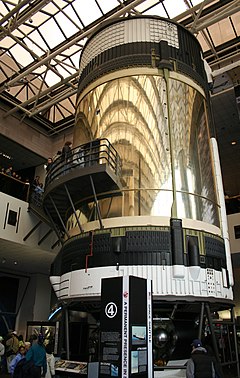 Skylab B Orbital Workshop at the National Air and Space Museum | |
| Station statistics | |
|---|---|
| Call sign | Skylab B, International Skylab, Advanced Skylab |
| Crew | 3 |
| Launch | canceled (currently at the National Air and Space Museum in Washington D.C.) |
| Mass | 77,088 kg |
| Height | 58 feet 5 inches (17.81 m) |
| Diameter | 21 feet 8 inches (6.60 m) |
| Days occupied | planned 56 to 90 days |
Skylab B was a proposed second US space station similar to Skylab that was planned to be launched by NASA for different purposes,[1][2] mostly involving the Apollo–Soyuz Test Project, but was canceled due to lack of funding. Two Skylab modules were built in 1970 by McDonnell Douglas for the Skylab program, originally the Apollo Applications Program. The first was launched in 1973 and the other put in storage, while NASA considered how to use the remaining assets from Apollo.
One considered option was to use Saturn V SA-515 to launch the backup Skylab station into orbit sometime between January 1975 and April 1976.[3] That way, it could expand the Apollo–Soyuz mission by 56–90 days.
Further proposals were made for an International Skylab, launched using Saturn V SA-514. This station would have been serviced by Apollo, Soyuz and later by the Space Shuttle.[3] The vision of an international space station would not be realized until two decades later.
- ^ David J. Shayler (2001). Skylab: America's Space Station. Springer Science & Business Media. p. 301. ISBN 978-1-85233-407-9.
- ^ David J. Shayler (2002). Apollo: The Lost and Forgotten Missions. Springer Science & Business Media. p. 275. ISBN 978-1-85233-575-5.
- ^ a b "Skylab B". Archived from the original on October 1, 2016.